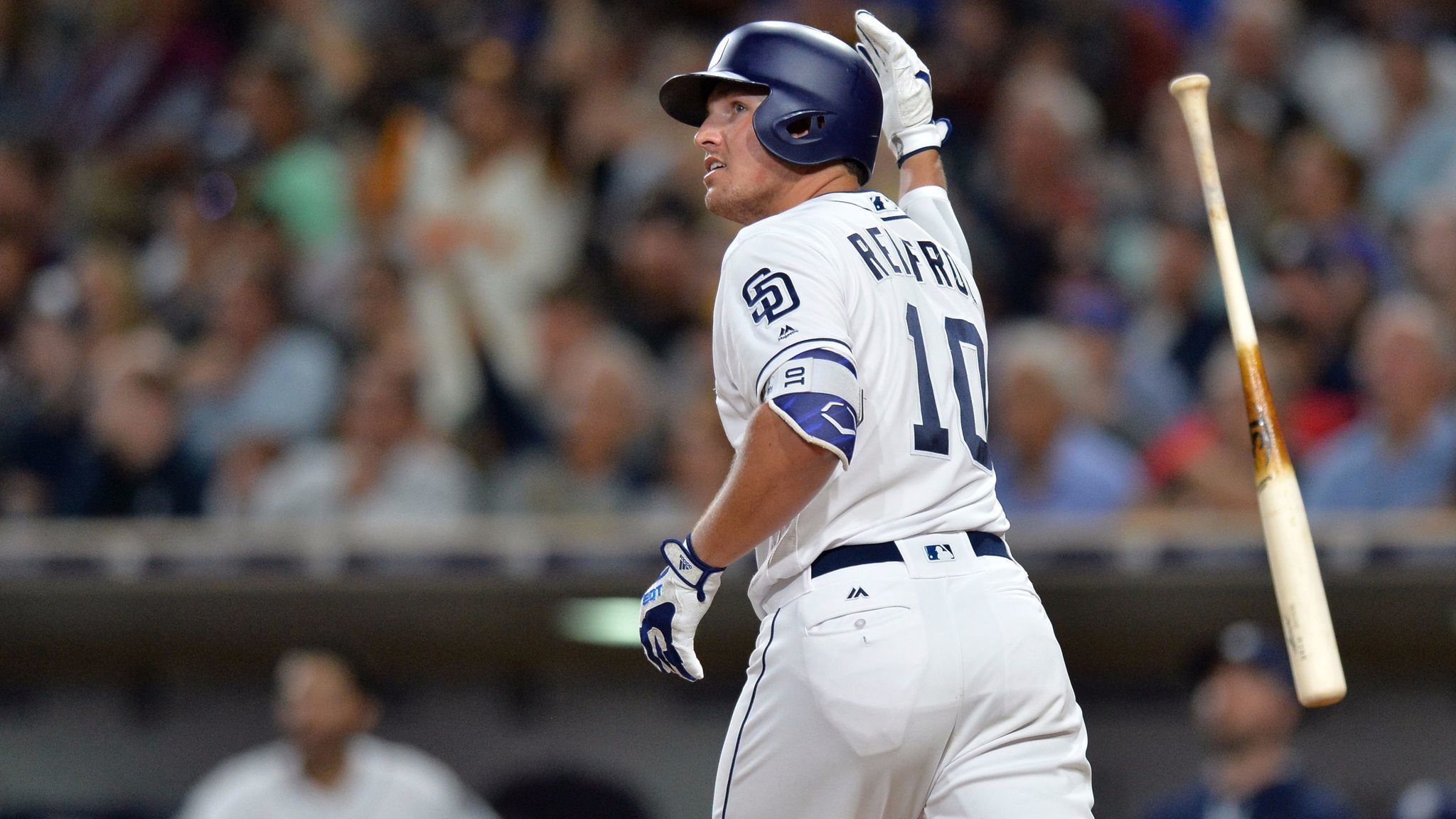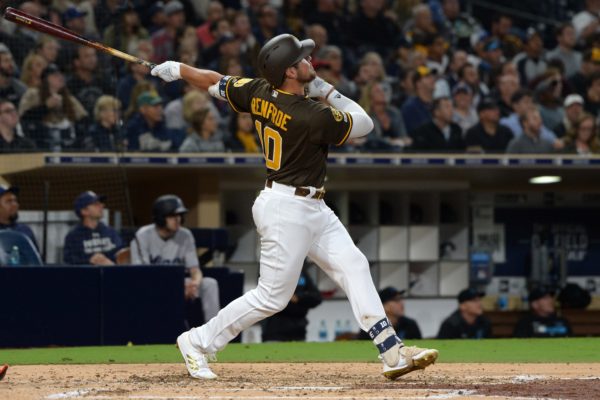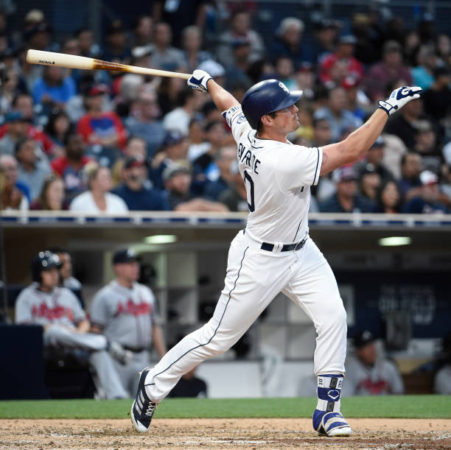Is the Padres’ Hunter Renfroe for real?

Credit: Jake Roth/Reuters Photo

San Diego Padres’ outfielder Hunter Renfroe is off to a hot start in 2019. Can the right-handed hitter keep up the pace?
There’s something about being a San Diego Padres fan which triggers the need to move on from players. Men having their best years are typically sold as quickly as possible, as if nothing good can last, especially not a first-round draft pick’s production.
In defense of the pessimist, the last Padres first rounder to have any decent value was Khalil Greene, the 2002 first rounder. Greene’s best season only netted an OPS+ of 101, but his 27 home runs and 97 RBI combined with exciting defense made him a fan favorite. He finished his career with 8.0 WAR according to FanGraphs, playing only one season after being traded to the St. Louis Cardinals.
Padres’ first rounders haven’t worked out well for most of the franchise’s recent history. A couple has gone on to play well for other teams, notably Rookie of the Year runner-up Trea Turner (11.6 WAR) for the Washington Nationals and Logan Forsythe (10.5 WAR). The Padres’ first-round picks have been so bad that one has to go back to 1994 to find another career 10 WAR player, Dustin Hermanson, who played for the Padres for two years with ERAs of 6.82 and 8.56 before being traded to the Florida Marlins for Quilvio Veras. (The Marlins traded Hermanson to the Expos, who sent him to the Cardinals for Fernando Tatis Sr.) The 1993 first rounder was Derrek Lee (34.3 WAR) who had 63 plate appearances for the Padres before being dealt for Kevin Brown. To find a Padres first-round draft pick who stuck with the team we have to go back to 1988 for Andy Benes (36.2 WAR). Benes was good for the Padres, but his best season came for the St. Louis Cardinals (18-10, 230.1 innings, 3.82 ERA, 5.1 WAR).
Halfway through the 2019 season, the Padres 2013 first round draft pick Hunter Renfroe is tied for fourth in the majors with 23 home runs, eighth in slugging, and 13th with a .935 OPS. He’s already exceeded his ZIPS and Steamer projections for the year, and he’s leading the Padres in home runs, total bases, and slugging. Renfroe also has yet to hit arbitration. He’s controllable by the Padres for four more years and making $582,000 this year. Beyond his production and value, Renfroe has given the Padres some of their biggest moments of the year; a three-home run game in Colorado and the first pinch-hit, walk-off grand slam in Padres’ history against the rival Dodgers.
But is Renfroe for real? Is he a late bloomer? Is his half-season a fluke? Already better than the models predicted, it’s worth comparing Renfroe to the draft class of 2013, and looking at his improvement over his career.
The draft of 2013 was incredibly interesting. Mark Appel was the eighth overall pick in 2012 but didn’t sign with the Pirates. The Astros took Appel first in 2013, but he has yet to pitch in the majors. The second pick was University of San Diego standout Kris Bryant. Bryant won Rookie of the Year and then the MVP. The 32nd pick was Aaron Judge who also won a Rookie of the Year, coming in second in MVP voting the same year, his age 25 season. Other picks, like the White Sox Tim Anderson (.687 OPS in 2018, .818 in 2019), Austin Meadows (.785/.928) and Hunter Dozier (.673/.987) haven’t broken out until this year. Renfroe’s numbers follow the latter group (.805/.945), but the increase in OPS is less extreme. This pattern is not a guarantee that any of these players have reached the next level, but it does suggest that Renfroe’s break out season is not abnormal.
Renfroe has hit better each of the last three years. His batting average, on-base, and slugging have all improved, his slugging most dramatically. His walk percentage has increased slightly, from 5.6 percent in 2017, to 6.8 percent in 18, to 7.7 percent this season. He remains below the MLB average at 8.4 percent, but given that Renfroe doesn’t have protection behind him in the order, pitchers seem to be challenging him instead of issuing the free pass. His infield fly percentage has dropped from 22 percent in 2018 to 14 percent this season, indicating that he’s putting more bat on the ball, and his decrease in ground balls suggest his launch angle is consistently going to put balls in the air. Additionally, Renfroe has decreased his strike swinging percentage from 24.5 percent to 22.3 percent, to 18.6 percent. He’s also slightly improved his pitches per plate appearance, rising just above the major league average.

Is Renfroe getting lucky? His batting average for balls in play has dropped to .244, suggesting that there is room for more batted balls to fall in for hits as his line drive percentage is steady at 21 percent. Other possibilities would indicate Renfroe is more lucky than good. As a right-handed hitter, he hits lefties better than right-handed pitching, but he’s improved his numbers against right-handers as well this season, hitting .237/.298/.584 against them. He still dominates left-handers (.326/.362/.837) but has faced lefties in only 20 percent of his at-bats, compared to 38 percent in 2018. On average, major leaguers have a platoon advantage of 30 percent of the time.
The adventure in Colorado helped Renfroe’s numbers, but Renfroe has been solid at Petco Park as well as he carries a home OPS of .893. By itself, that OPS would be good enough for 37th in the majors. Away from Petco, Renfroe’s OPS is .987, which would be good enough for eighth in the league. Compared to hitters that have a great home field advantage to their numbers like Charlie Blackmon (1.487 Home, .660 Road OPS), Renfroe not only lacks an advantage at home, he hits well in a park known for being tough to hit in. This year Petco is dead last in Park Factor, but not only can Renfroe hit at home, but he also leads the Padres in OPS at home.
Put these numbers together, and we have the profile of a player who is waiting for a good pitch to hit. While Hunter doesn’t have the exceptional patience of an elite hitter, he seems to be getting better at recognizing good pitches and doing a lot of damage when he connects. He doesn’t walk a lot, but there are few reasons to pitch around him as the bottom of the Padres order is relatively weak. Renfroe has driven himself in 23 times via home run, but he has scored only 11 times when a teammate drove him in. In 13 starts in June, for example, Reyes has batted behind Renfroe twice, with Josh Naylor, Wil Myers, and Ian Kinsler behind him the other 11 starts. Somehow, Renfroe has put up a .259/.344/.741 line in June with eight home runs, though those numbers are elevated with his three-home run game in Coors.
Renfroe does not appear to be getting lucky with matchups, balls in play, or protection in the lineup. His jump in slugging this year is supported by a more patient approach at the plate. Further, Renfroe’s sudden increase in performance is similar to that of other 2013 first round picks. These stats point to Renfroe continuing his production, possibly taking more walks as teams pitch around him in the second half of the season, increasing his on-base percentage as long as he remains disciplined at the plate.
Two competing theories shift the view of Renfroe as the season progresses. On the one hand, the idea that Renfroe will regress towards his career numbers. On the other, his batted balls in play will increase towards the league average of .297. It’s more likely that neither factor impacts Renfroe’s numbers. Renfroe is going to hit a lot of fly balls because he swings for the fences. Batting average of balls in play will remain stable for the most part, as fly balls get caught more often than line drives, and Renfroe’s speed isn’t going to get him a lot of infield hits. While any player is susceptible to a second-half crash, Renfroe’s production has been consistent or improving by many measures. He’s hitting right-handers, he hits at home, on the road, and he rarely hits with protection in the lineup. For these reasons, Padres fans should be optimistic about Renfroe’s second half, and the Padres offense with Renfroe’s bat in the lineup.
The flip side to that is if there are two outs and a man on second and a poor hitter batting behind you, you don’t want to walk because that decreases your chance of scoring. Because Renfroe isn’t getting good pitches to hit, he looks at putting bad pitches in play instead of walking, because walks are less valuable if the guy behind you can’t hit. Sometimes there are 4-5 guys behind him that can’t hit.
You don’t understand lineup protection. If a hitter has poor batters behind him, then he will see less good pitches to hit. He will get walked more, not less.
Think two examples. In 1961 Roger Maris was going nuts with the long ball, but he wasn’t intentionally walked all year. Not even one time. Why? Because Mickey Mantle hit behind him, and no team was walking anyone to pitch to Mantle, period. That’s lineup protection.
Then there was high-steroid usage era Barry Bonds, who in 2004 got intentionally walked 120 times! Why? On opening day the player who batted behind Bonds was Edgardo Alfonso. See the difference? Later in the year it was J.T. Snow, but never was it anyone remotely close to Mantle’s level.
So if you believe in lineup protection, then Renfroe should have seen his walk rate spike, with teams refusing to let him beat them, and pitching to anyone else instead. But because Renfroe hits for a low batting average and a very poor on base percentage, teams will pitch to him.
So you mean like when Renfroe moved into the hole, Machado’s bat went to a new level.
The comment and being the last real threat to drive in a run or two is TRUE. Especially when Renfroe batted 5th or 6th. Runners on help in front of you also.
Walks only plate a run when the bases are loaded. Renfroe has walked more lately and has some singles and doubles mixed in, he gets left on base allot.
Captain non sequitur.
Hence the reason the team should not trade him! The offense has started to round into shape. Keep what is working and move on from what is not. The strength in our minor leagues is skewed toward pitching. Those players will be coming. Though I agreed with bring up Tatis and Paddack ,let’s not go for broke! Face facts, the Padres are not built to compete against the true Giants (sorry fans of ;)) in the league this year. We are just too many players away from contenting past a first round wildcard spot. I want us to contend for WS ring next year not an Iffy wc (WC) banner this year. We need to hold onto the players other teams want or we’ll be knocking on their doors looking for pieces we gave away. It would be amazing to make the post season this year, but not at the cost of future years. Per this article’s surmise Renfroe is continuously improving. Players will come up on the free agent market that will help. Power is easier to come by then pitching on the open market. Nuff said I’m boring myself now.
Enjoyed the article, thanks Mr. Pierce.
You didn’t mention Renfroe’s DEFENSE at all. Since April 26th he is the 7th best OF in baseball.
For a team built on youth, at some point you have to keep what you develop, fill in the gaps, and hope that is enough. As you stated the Padres historically have done this very poorly. They have drafted poorly over the years also, passing on Trout for Tate, passing on Verlander. It is time we let these developed players succeed in San Diego.